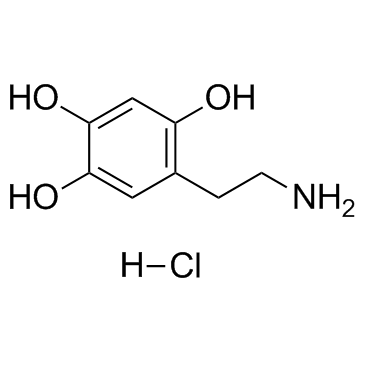Oxidopamine hydrochloride

Oxidopamine hydrochloride structure
|
Common Name | Oxidopamine hydrochloride | ||
|---|---|---|---|---|
| CAS Number | 28094-15-7 | Molecular Weight | 205.63900 | |
| Density | N/A | Boiling Point | 406ºC at 760 mmHg | |
| Molecular Formula | C8H12ClNO3 | Melting Point | 232-233ºC (dec.)(lit.) | |
| MSDS | Chinese USA | Flash Point | 199.3ºC | |
| Symbol |

GHS07 |
Signal Word | Warning | |
Use of Oxidopamine hydrochlorideOxidopamine hydrochloride is a neurotoxic synthetic organic compound, selectively destroys dopaminergic and noradrenergic neurons in the brain. |
| Name | 6-Hydroxy Dopamine Hydrochloride |
|---|---|
| Synonym | More Synonyms |
| Description | Oxidopamine hydrochloride is a neurotoxic synthetic organic compound, selectively destroys dopaminergic and noradrenergic neurons in the brain. |
|---|---|
| Related Catalog |
| Boiling Point | 406ºC at 760 mmHg |
|---|---|
| Melting Point | 232-233ºC (dec.)(lit.) |
| Molecular Formula | C8H12ClNO3 |
| Molecular Weight | 205.63900 |
| Flash Point | 199.3ºC |
| Exact Mass | 205.05100 |
| PSA | 86.71000 |
| LogP | 1.80690 |
| Vapour Pressure | 3.58E-07mmHg at 25°C |
| Storage condition | 2-8℃ |
CHEMICAL IDENTIFICATION
HEALTH HAZARD DATAACUTE TOXICITY DATA
|
| Symbol |

GHS07 |
|---|---|
| Signal Word | Warning |
| Hazard Statements | H315-H319-H335 |
| Precautionary Statements | P261-P305 + P351 + P338 |
| Personal Protective Equipment | dust mask type N95 (US);Eyeshields;Gloves |
| Hazard Codes | Xi: Irritant; |
| Risk Phrases | R36/37/38 |
| RIDADR | NONH for all modes of transport |
| RTECS | DC4650000 |
|
Gene therapy with AAV2-CDNF provides functional benefits in a rat model of Parkinson's disease.
Brain Behav. 3(2) , 75-88, (2013) Cerebral dopamine neurotrophic factor (CDNF) protein has been shown to protect the nigrostriatal dopaminergic pathway when given as intrastriatal infusions in rat and mouse models of Parkinson's disea... |
|
|
Functional Role of the Disulfide Isomerase ERp57 in Axonal Regeneration.
PLoS ONE 10 , e0136620, (2015) ERp57 (also known as grp58 and PDIA3) is a protein disulfide isomerase that catalyzes disulfide bonds formation of glycoproteins as part of the calnexin and calreticulin cycle. ERp57 is markedly upreg... |
|
|
LPA signaling is required for dopaminergic neuron development and is reduced through low expression of the LPA1 receptor in a 6-OHDA lesion model of Parkinson's disease.
Neurol. Sci. 36 , 2027-33, (2015) Lysophosphatidic acid (LPA) is a bioactive phospholipid that activates at least five known G-protein-coupled receptors (GPCRs): LPA1-LPA5. The nervous system is a major locus for LPA1 expression. LPA ... |
| 6-Hydroxydopamine hydrochloride |
| 6-HYDROXYDOPAMINE HYDROCHLORIDE |
| 5-(2-Aminoethyl)benzene-1,2,4-triol hydrochloride |
| Oxidopamine (hydrochloride) |

